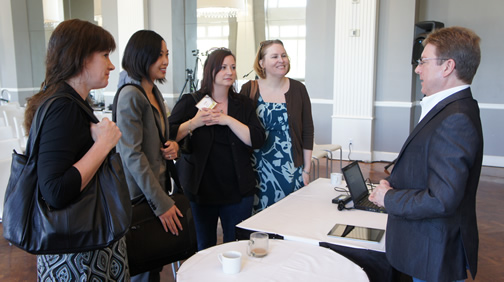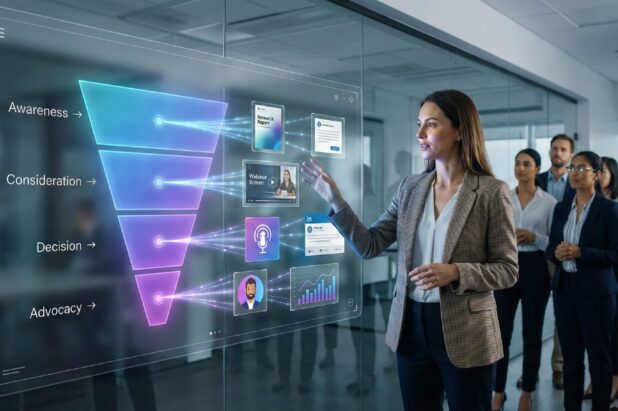 On a sunny, warm day in Minneapolis, marketers gathered near one of the city’s best attractions – LakeCalhoun – to learn about “Search and the Connected Consumer”, a view of how people retrieve information online and what that means for the future online and search engine marketing.
On a sunny, warm day in Minneapolis, marketers gathered near one of the city’s best attractions – LakeCalhoun – to learn about “Search and the Connected Consumer”, a view of how people retrieve information online and what that means for the future online and search engine marketing.
Hosted by MIMA, the event featured Mike Grehan, Global VP Content, Search Engine Watch, ClickZ & Search Engine Strategies.
Mike started by educating the audience on the history of the World Wide Web and the Internet (note: they are not one in the same).
The idea of collecting information and making it available to the masses was on the minds of intellectuals/scientists long before it came to fruition into the World Wide Web. For example, in 1945 Vannevar Bush – a prominent scientist and a key person behind the creation of the Atomic Bomb – argued that as humans turned from war, scientific efforts should shift from increasing physical abilities to making all previously collected human knowledge more accessible.
Fast forward to 1998 and consider Google’s mission statement: “To organize the world’s information make it universally accessible and useful” and it sounds pretty familiar.
Next, Grehan spent a few minutes explaining how search engines work via the following 3 steps:
1. Crawling the Web
Most people are aware that Google ‘crawls the web’, the crawlers follow links and collect text. However, the crawlers themselves have very little to do if anything with ranking.
2. Indexing the Web
A crawler comes to a website, content is parsed out and an inverted index is created to identify what terms exist on what pages/documents. Think of an index in the back of a book – “chocolate” appears on pages 32, 157 and 256.
3. Analyzing the Web
Ranking content based solely on instances of keyword phrases on a web page quickly proved to be a flawed method because all a site had to do to improve its ranking was have more instances of the term on a page, whether relevant or not to the end user.
This is where hyperlink analysis for the web came into play as well as the idea of hubs, authorities and communities which identifies how and where different sites within similar communities, are linking and related to each other. Not all links are equal – some links are more equal than others. And some are infinitely more equal.
Hyperlink analysis algorithms make either one or both of these assumptions:
Assumption #1 – A hyperlink from page A to page B is a recommendation of page B by the author of page A
Assumption #2 – If page A and page B are connected by a hyperlink, then they might be on the same topic – they’re related
Search engines look further into link relationships to understand: If page C cites pages A and B, then A and B are said to be co-cited by C
Page A and B being co-cited by many other pages is evidence that A and B are somehow related to each other
Confused? Grehan breaks it down into this easier to understand statement:
Company websites can use keyword phrases and position themselves as the ‘Leader of Whatever’, but Google is asking ‘who else says so?’.
Links help distill the picture and identify votes of authority about your content by others.
The new science of networks and the addition of cyber communities has further impacted the need for quality, relevant links over quantity.
Other factors that influence ranking include Query Chains and User Trails.
Query Chains are Google’s ability to understand the cognitive processes a human will undertake when searching for information.
For example, if ‘enough’ people search for ‘special edition’, then ‘special collections’ and then ‘limited editions’ to find the result they want for limited edition books, Google will eventually serve the results for ‘limited editions’ when someone types in ‘special edition’ knowing what content they are most likely looking for.
Next is User Trail data which is collected by understanding what searchers click on and continue clicking links to additional content vs what they click on and hit the ‘back button’. Too many clicks to the back button for any particular search result can potentially lead to a dip in ranking position.
Now, that the audience was up-to-speed on how search engines work (or have worked to-date) the conversation turned toward the changing end user, aka “The Connected Consumer”.
In short, the end user – me, you, your prospects, grandma and everyone in between has changed and so too did the search experience.
We went from being satisfied with 10 blue links on a search results page to wanting more options and more ways to interact with information more quickly. The now ‘old-news’ roll out of Universal Search is still a significant change in the search experience if we are looking back of the evolution of search.
Images, video and now social updates appearing directly on the SERP (search engine results page) provide a quite different experience for the searcher.
So what can we gain from understanding the premise of compiling the world’s information, knowing how the search engines work and how they are changing? Better insight into how we better approach online marketing and specifically content marketing activities.
According to Grehan, to do this most effectively companies will need to transition from creating content for Google and rather focus on the people they are trying to reach (not the channels in which you try to reach them).
To do this, we need to understand user intent.
Informational
“This applies to the surfer who is really looking for factual information on the web. So they make a query like ‘low hemoglobin’ for instance. This is a medical condition. They are looking for specific info about this condition. That’s very close to classical information retrieval.”
Navigational
“When a surfer really wants to reach a particular website. If they do a query for Best Buy for example. What they probably want is to go directly to the website, as opposed to find a Wikipedia page on the history of the company.”
Transactional
“Transactional searches are when the surfer wants to do something on the web, through the web. Shopping, downloading a whitepaper, finding a service. In this case the searcher wants to find a search result that helps them complete the action or satisfies a need.”
What we do with this information is create content to help satisfy the intent of the searcher, thereby creating quality content that people will find helpful and ultimately may link to/share with their community. And this is perhaps the biggest change in search which is the shift toward information-seeking on social sites. No longer does the end user have to go Google or any other search engine to find information.
The same end user which is placing more trust in 3rd party content and reviews is also finding ways to side-step browsers and instead accomplishing goals through the Internet/Apps.
In summary, the Connected Consumer is finding new ways to discover and interact with information, placing more value in non-traditional sources. Decision makers no longer act independently of each other but are all the more connected to other consumers, to other channel members and often to brands.
In turn, brands and companies are now vying for central position inside consumer networks and need to determine how they can best create information that satisfies the user intent, is recognized as valuable by other sources and available to the audience in the formats they prefer. This is a model not unlike the Persona Discovery, Consumption and Sharing approach we promote at TopRank Marketing.
Have thoughts on the best ways to connect with the Connected Consumer? Share them in the comments below!


